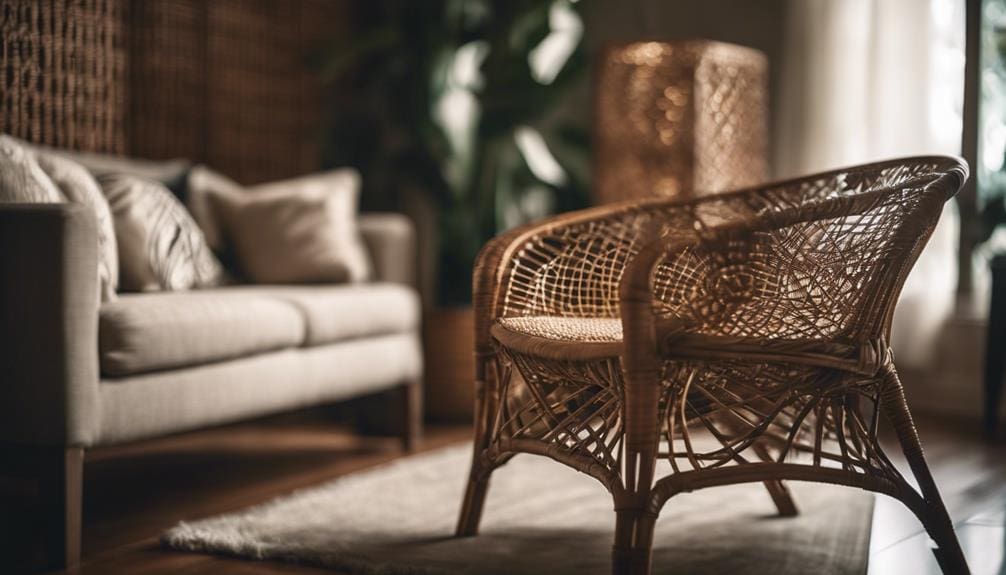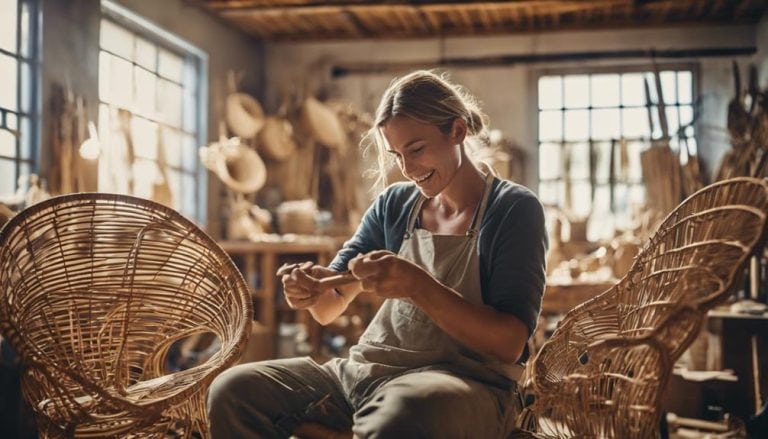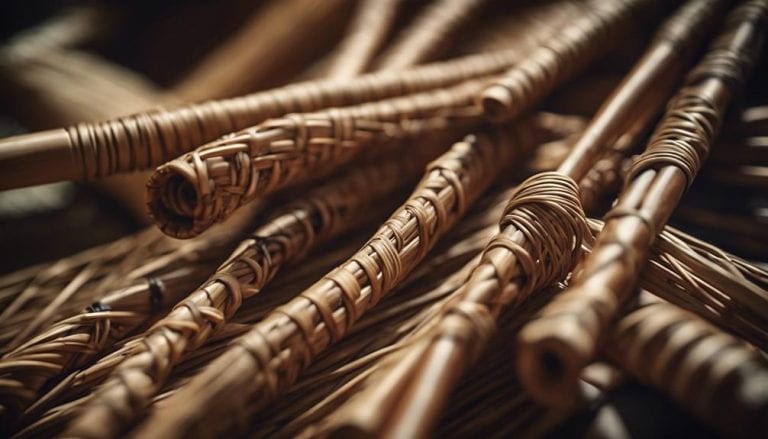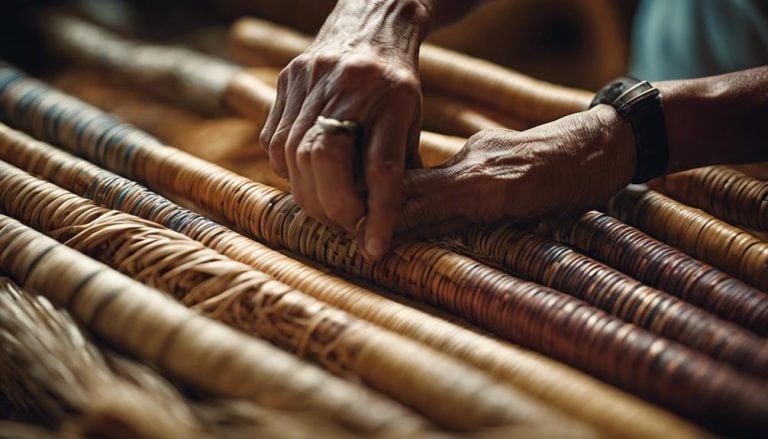Rattan Cane in Contemporary Weaving Designs
Interestingly, over the past five years, there’s been a 70% increase in the use of rattan cane in contemporary weaving designs, a testament to its growing appeal among designers and consumers alike. As a writer deeply engrossed in the nuances of modern crafting materials, I’ve observed how this surge highlights rattan’s versatility and durability and reflects a broader trend towards sustainable and naturally sourced materials.
The intriguing aspect that warrants further exploration is how artisans are innovatively incorporating traditional weaving techniques with modern aesthetics to create functional and visually captivating pieces. This blend of old and new raises important questions about the future of craft and design, inviting a closer look at the potential of rattan cane in reshaping our spaces and lifestyles.
In contemporary weaving designs, rattan cane adds a touch of natural elegance and durability, enhancing the pieces’ aesthetic appeal and structural integrity. Its versatility and eco-friendly nature make it popular among designers seeking style and sustainability.
Key Takeaways
- Rattan cane weaving combines traditional craftsmanship with modern aesthetics for unique interior designs.
- Sustainable and rapid renewability make rattan a preferred material for eco-conscious decor.
- Innovative weaving techniques, such as grids and honeycomb, offer diverse textures for contemporary spaces.
- Fusion with materials like metal and leather enhances rattan’s versatility in design applications.
The Resurgence of Rattan
Amidst the shifting sands of design trends, rattan has woven its way back into the heart of contemporary decor, celebrated for its sustainable charm and versatile beauty. Its resurgence isn’t just a nod to nostalgia but a profound statement about our environmental consciousness and the aesthetic value we place on our spaces. With its minimal ecological impact, rattan embodies a design philosophy that marries form with function and beauty with sustainability.
The allure of rattan lies in its natural, inviting texture and in the stories of artisanal craftsmanship it carries. Each piece is a testament to cultural significance, a narrative of timeless skills passed down through generations. This artisanal touch brings authenticity and soulfulness to modern interiors, creating a connection that transcends the visual.
As I’ve integrated rattan into my space, I’ve felt a deeper resonance with the principles of eco-friendly living and design aesthetics. It’s more than just decor; it’s a choice that reflects a commitment to sustainability and an appreciation for the beauty of natural materials. The cultural significance and artisanal craftsmanship behind each woven pattern enrich my home, making rattan an irreplaceable contemporary design element.
Design Innovations
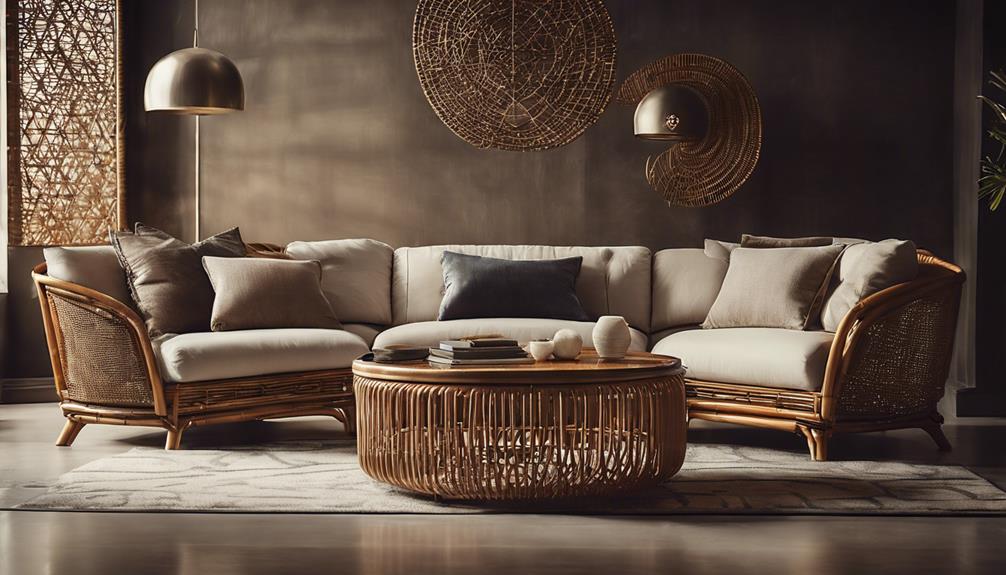
In contemporary decor, rattan cane weaving is evolving remarkably, blending traditional techniques with modern design elements to craft aesthetically captivating and uniquely innovative pieces. I’ve observed an intriguing shift towards material fusion, where the warmth of rattan meets the coolness of metal and the luxurious texture of leather, creating a symphony of contrasts that’s simply breathtaking.
Artistic expression shines through as designers reinterpret classic patterns like the Grid Weave and Honeycomb Weave, infusing them with a modern twist that speaks volumes of creativity and innovation.
- Material fusion evokes a sense of harmony in diversity, blending the old with the new in an exciting dance of textures.
- Artistic expression allows for a personal touch, transforming each piece into a unique statement that resonates deeply.
- Cultural influences breathe life into designs, imbuing them with stories and traditions that enrich our living spaces.
- A minimalist approach strips back the unnecessary, focusing on the beauty and simplicity of the weave, inviting calm and serenity into our homes.
This journey into design innovations in rattan cane weaving has been an exhilarating exploration of how traditional craftsmanship can meld with contemporary aesthetics to create something truly special.
Sustainable Choices
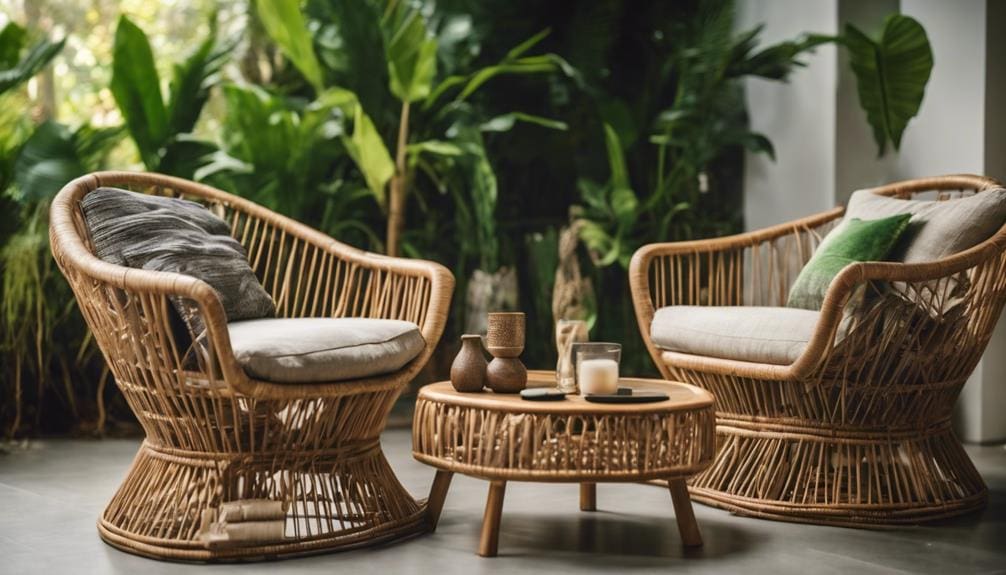
Opting for rattan cane in our weaving designs offers a sustainable path forward, marrying rapid renewability with a reduced environmental footprint. It’s an embrace of nature’s resilience, allowing us to craft pieces that are visually stunning and kind to our planet. This choice is a testament to our commitment to eco-friendly alternatives where artisanal craftsmanship meets the demands of ethical interiors.
Incorporating rattan cane into contemporary designs isn’t just about aesthetics; it’s a deliberate choice to support sustainable decor. Each curve and weave tells a story of preservation and respect for natural resources, echoing a growing trend towards more responsible consumer choices. By choosing rattan, we’re not just making a statement; we’re participating in a movement that values the environment as much as innovation.
This journey towards sustainable and ethical interiors isn’t just about what we create but how we inspire others. With its gentle impact on the earth and capacity for renewal, Rattan cane offers a blueprint for the future of design. It bridges tradition and modernity, where eco-friendly alternatives become the cornerstone of artisanal craftsmanship.
Weaving Techniques Explored

Exploring the artistry of rattan cane weaving unveils a world where traditional grid patterns blend seamlessly with modern honeycomb designs, showcasing the versatility and innovation within contemporary crafts. As I delve deeper into the intricacies of these weaving techniques, I’m captivated by the harmonious blend of simplicity and complexity that defines our modern aesthetic.
- With its calm visual appearance, the grid weave whispers tales of tradition, grounding us in the familiar comfort of the past.
- In contrast, honeycomb weave invites a soft, textural embrace, hinting at the endless possibilities of modern patterns.
- Each weave pattern, whether a grid or honeycomb, serves as a canvas, inviting us to touch, feel, and connect with the textural elements that speak volumes beyond their visual appeal.
- The choice between these techniques is not just a design decision; it’s a heartfelt journey toward creating spaces that are innovative and intimate.
Understanding the nuances between grid and honeycomb weaves has allowed me to appreciate the depth and texture they bring to contemporary designs. It’s a testament to how modern patterns can coexist with traditional methods, creating a rich tapestry that resonates with our desire for connection and beauty.
Rattan in Modern Furniture
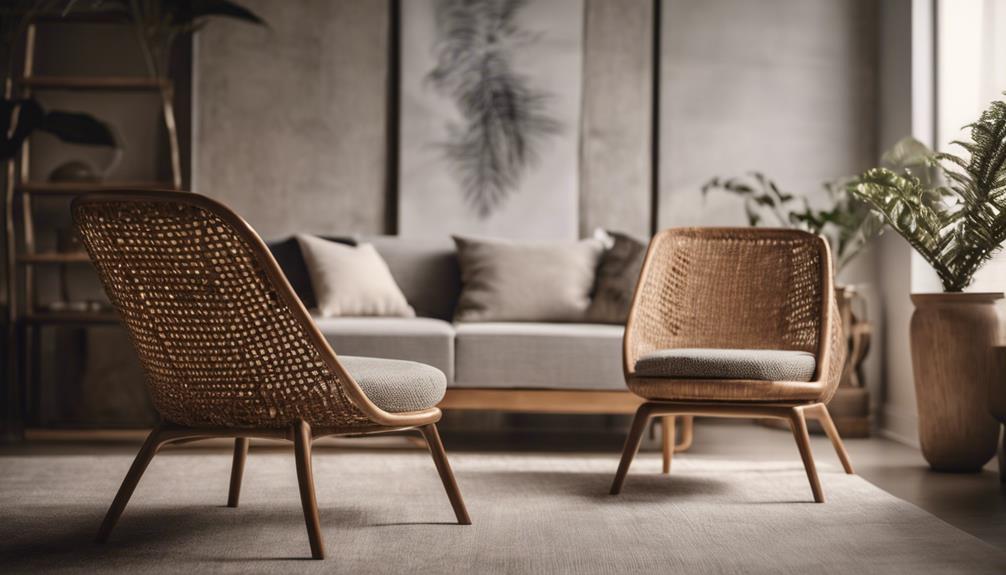
As we shift focus to modern furniture, it’s evident that rattan cane has become a cornerstone in creating pieces that blend durability with a natural, stylish aesthetic. The material, celebrated for its flexibility and strength, has found its way into the hands of visionaries like Eva Harlou and Federica Biasi. These designers have embraced rattan’s traditional appeal and propelled it into the future with innovative applications that challenge our perceptions of furniture.
Their creative collaborations have seen classic forms reimagined, where the fluidity of rattan cane weaving breathes life into static structures, resulting in furniture that’s as much a piece of art as a functional object. This adventurous spirit has led to the creation of pieces echoing a modern sensibility yet rooted in an intrinsic connection to nature.
Moreover, the sustainable ethos surrounding rattan cane aligns perfectly with the increasing demand for eco-friendly design solutions. It’s a testament to how traditional materials can be adapted to fit the modern narrative, offering a touch of organic warmth and texture to contemporary interiors. Through these explorations, rattan in modern furniture is a beacon of artistic innovation and environmental consciousness.
Decorative Accents and Accessories
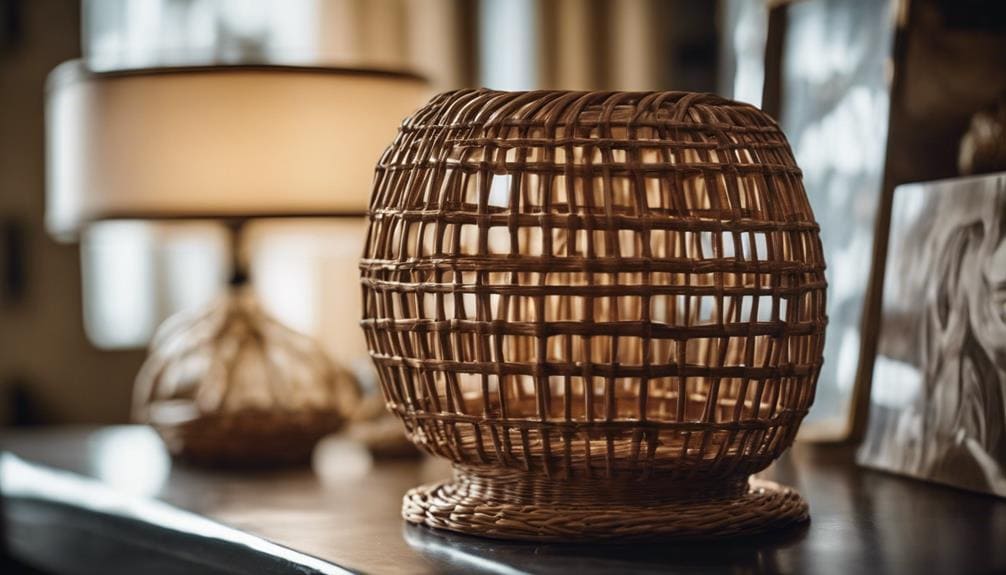
Delving into decorative accents and accessories, I’ve discovered that rattan cane’s versatility ignites a creative spark, transforming everyday items into expressions of sustainable elegance. This material, interwoven with nature’s essence, brings natural warmth and texture to our spaces and stands at the forefront of eco-friendly weaving in home decor.
- The gentle whispers of rattan cane trends in interior styling sing stories of tradition and innovation, inviting us to blend the past with the present in our sanctuaries.
- Each basket, tray, and lamp weaves a narrative of meticulous craftsmanship, embodying the spirit of eco-friendly decor that doesn’t just serve a purpose but tells a tale.
- The versatility of rattan cane allows us to craft unique, customizable design elements that echo our deepest desires for a home that feels trendy and intimately ours.
- Incorporating this sustainable aesthetic into our living spaces brings a sense of serenity and connection to the earth, making our homes a sanctuary for our bodies and our planet.
Rattan cane offers a harmonious blend of beauty and sustainability, a testament to the enduring allure of nature in our homes.
Crafting and DIY Trends
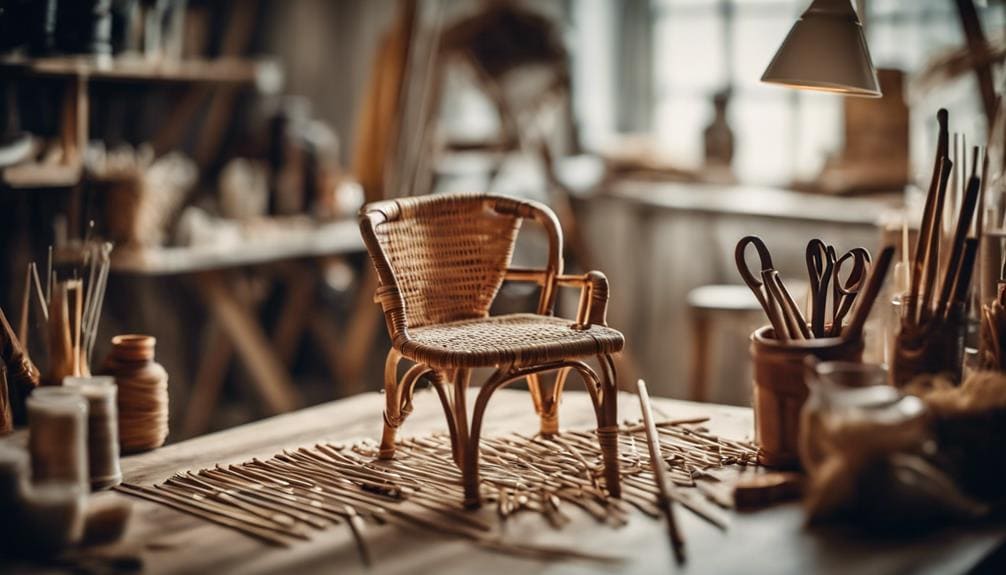
In crafting and DIY trends, I’ve found that weaving with rattan cane unleashes a surge of creativity and offers a sustainable path to crafting bespoke, stylish pieces that beautifully blend modern aesthetics with a touch of nature’s charm. The versatility and eco-friendliness of rattan cane make it an ideal medium for my creative projects. From trendy decor to personalized gifts, the possibilities are limitless. Each weave infuses a piece of my soul into stylish creations, transforming spaces with a contemporary yet natural flair.
Diving deeper into the art, I’ve explored various techniques, allowing me to customize every aspect of my work. This personal touch turns each project into a trendy, one-of-a-kind piece that resonates with my aesthetic and values. Rattan cane’s natural texture and strength have empowered me to design everything from wall hangings to chic, woven furniture, each embodying a slice of modern design mixed with traditional craftsmanship.
Crafting with rattan cane isn’t just about creating; it’s about expressing individuality through sustainable, fashionable designs. It’s a journey of turning simple strands into intricate, personalized gifts and home decor, each telling its unique story.
Frequently Asked Questions
Does Rattan Go With Modern?
Rattan complements modern design beautifully. Its durability and material versatility blend with sleek aesthetics, adding warmth and texture. I’ve seen how it creates a cozy, intimate vibe while maintaining a clean, contemporary look.
Why Is Rattan Trending?
I’m drawn to rattan’s trending nature because it merges eco-friendliness with durability, appealing deeply to my love for sustainable living. Its strength and green appeal touch my heart, reshaping how I view modern décor.
What Design Style Is Cane Furniture?
I’d describe cane furniture’s design style as a romantic blend of colonial aesthetics and Bohemian vibes. It’s like weaving history and free-spirited artistry into every piece, creating an intimate ambiance in any room.
What Are Some of the Traditional Designs Used in Rattan Weaving?
Exploring rattan weaving, I’ve found traditional designs like basket patterns and cultural motifs enthralling. These patterns blend art with intimacy, offering a unique touch to each piece I create or encounter.
Conclusion
As I weave through the narrative of Rattan’s resurgence, it’s clear that this isn’t just a return but a renaissance. Like Phoenix rising from the ashes, rattan has emerged, reborn into contemporary designs that blend tradition with innovation. The delicate dance of Grid and Honeycomb Weaves on furniture and accessories echoes a sustainable future, marrying the past with the present. This isn’t merely about crafting; it’s about creating stories, one intricate weave at a time, ushering in an era where artistry and sustainability intertwine.

